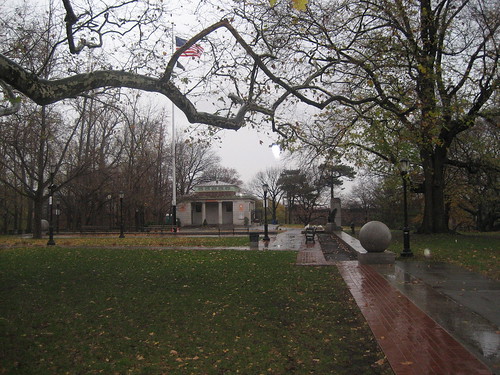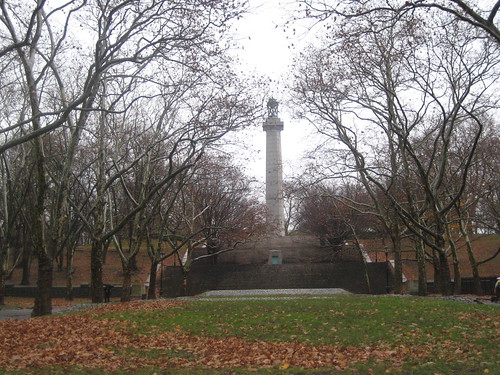Archive for December, 2009
Incredibly, super-belated, end-of-the-line field trip post
So, in the waning minutes of this semester, I realized that I had not yet written about our first field trip.
Since I did my final project on a revolutionary, Jose Marti, the memory of standing behind the wall on Sunken Road that the Confederate soldiers used has been on my mind a lot. Just imagining thousands of young soldiers lying dead was a very powerful image and really brought Whitman’s post-battle descriptions home to me. And it would not have been those whom we consider “the good guys” lying on the ground in front of Sunken Road. It was a deathtrap for Union soldiers. For me, that contributed to an already very powerful image that can easily be applied to a revolution and, in light of my recent research and writing, made the weight of Jose Marti’s ideas apparent.
During his life, Marti was calling his fellow countrymen to revolt against Spanish rule over Cuba. Even though Spain was weak compared to the other major European powers at that time, they far outstripped the military strength of the Cuban forces. When he said that he wanted his people to fight with him, Marti knew that he was potentially putting them in the same situation as the Union soldiers were in at Fredericksburg. They were the people who we consider the ‘good guys.’ They were fighting against colonial tyranny. It just casts war in a whole new light to go to a battlefield.
Incredibly, super-belated, end-of-the-line field trip post
So, in the waning minutes of this semester, I realized that I had not yet written about our first field trip.
Since I did my final project on a revolutionary, Jose Marti, the memory of standing behind the wall on Sunken Road that the Confederate soldiers used has been on my mind a lot. Just imagining thousands of young soldiers lying dead was a very powerful image and really brought Whitman’s post-battle descriptions home to me. And it would not have been those whom we consider “the good guys” lying on the ground in front of Sunken Road. It was a deathtrap for Union soldiers. For me, that contributed to an already very powerful image that can easily be applied to a revolution and, in light of my recent research and writing, made the weight of Jose Marti’s ideas apparent.
During his life, Marti was calling his fellow countrymen to revolt against Spanish rule over Cuba. Even though Spain was weak compared to the other major European powers at that time, they far outstripped the military strength of the Cuban forces. When he said that he wanted his people to fight with him, Marti knew that he was potentially putting them in the same situation as the Union soldiers were in at Fredericksburg. They were the people who we consider the ‘good guys.’ They were fighting against colonial tyranny. It just casts war in a whole new light to go to a battlefield.
Another Look at Fort Greene
Fort Greene
History is all around us, especially in Whitman’s Brooklyn. I am aware that New York City has many historical landmarks but I didn’t realize the significance of Fort Greene and how Whitman helped create it.
The class met at the park, along the way I saw Walt Whitman projects across the street. We met in the spot below near the small building:
We where greeted by people from the Whitman Project.
The CUNY Walt Whitman class had the pleasure and privilege to be guided by artistic director Greg Trupiano. He gave us some background
We first spoke about Leaves of Grass. The artistic director (Greg Trupiano) pointed out some physical qualities of the first book and an image of Whitman. Most people in the 19th century, especially writers like Emerson dressed in a very professional manner. Whitman instead is dressed in a working man’s clothes. He looks like a regular blue collar worker in his book of poems. This is more significant then I thought and one of the reasons that Whitman is seen as the people’s poet.

Blue Collar Whitman
Mr. Black who is another person affiliated with the Whitman project read a poem from Whitman’s Collection. I didn’t get a chance to record his passionate reading but I think one of my classmates capture it with a flipcam.
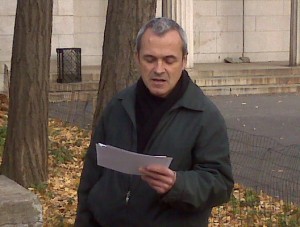
The next discussion was about setting type. The image below is a keep sake that Greg Trupiano gave the class from his own private collection.
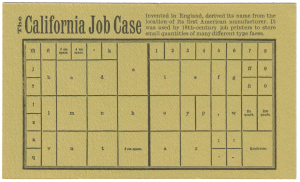

We then dicussed the reasons why Whitman pushed for the creation of Fort Greene. To summarize:
1. He felt the Wallabout Martyrs deserved a proper monument.
2. He used his influence as the editor of the Daily Eagle to persuade people to support his cause.
3. He lived in the area and thought that people should have a park to enjoy.
Fun Anecdote # 1
I learned about how the terms uppercase and lowercase came about. Uppercase or capital characters are higher and harder to reach then lowercase when people use to set type; makes sense.
Fun Anecdote #2
“Having a copyright doesn’t mean you wrote the book.”
Fun Anecdote #3
Leaves of Grass was banned in Boston in the early 1880s which added to the book’s controversy. Subsequently, the 1880 copy was the best selling edition of Leaves of Grass.
We made our way torward The Tombs which you can see in the video below.
The Tomb is really an incredible piece of history. Some of the old bones from the old memorial wihch just fell apart over time.
Best picture I took in my life… ever
Our tour concluded with a walk around the Brooklyn neighborhood and a look at 99 Ryerson street. It’s the last piece of history in New York that Whitman lived in that is still standing today. Students from Pratt currently inhabit the building.
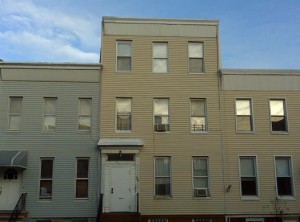
Resources: These are additional links to learn more about Walt Whitman and the park
[1] This is the website of Greg Trupiano about Whitman http://www.whitmanproject.org/
[2]Wikipedia is a decent place to start when looking for leads and additional information regarding a topic. It is by no means authoritative. http://en.wikipedia.org/wiki/Fort_Greene
[3] Fort Greene Park Conservancy http://www.fortgreenepark.org/pages/contents.htm
[4] This website provides a historic context of the park: http://www.historicfortgreene.org/
Another Look at Fort Greene
Fort Greene
History is all around us, especially in Whitman’s Brooklyn. I am aware that New York City has many historical landmarks but I didn’t realize the significance of Fort Greene and how Whitman helped create it.
The class met at the park, along the way I saw Walt Whitman projects across the street. We met in the spot below near the small building:
We where greeted by people from the Whitman Project.
The CUNY Walt Whitman class had the pleasure and privilege to be guided by artistic director Greg Trupiano. He gave us some background
We first spoke about Leaves of Grass. The artistic director (Greg Trupiano) pointed out some physical qualities of the first book and an image of Whitman. Most people in the 19th century, especially writers like Emerson dressed in a very professional manner. Whitman instead is dressed in a working man’s clothes. He looks like a regular blue collar worker in his book of poems. This is more significant then I thought and one of the reasons that Whitman is seen as the people’s poet.

Blue Collar Whitman
Mr. Black who is another person affiliated with the Whitman project read a poem from Whitman’s Collection. I didn’t get a chance to record his passionate reading but I think one of my classmates capture it with a flipcam.

The next discussion was about setting type. The image below is a keep sake that Greg Trupiano gave the class from his own private collection.


We then dicussed the reasons why Whitman pushed for the creation of Fort Greene. To summarize:
1. He felt the Wallabout Martyrs deserved a proper monument.
2. He used his influence as the editor of the Daily Eagle to persuade people to support his cause.
3. He lived in the area and thought that people should have a park to enjoy.
Fun Anecdote # 1
I learned about how the terms uppercase and lowercase came about. Uppercase or capital characters are higher and harder to reach then lowercase when people use to set type; makes sense.
Fun Anecdote #2
“Having a copyright doesn’t mean you wrote the book.”
Fun Anecdote #3
Leaves of Grass was banned in Boston in the early 1880s which added to the book’s controversy. Subsequently, the 1880 copy was the best selling edition of Leaves of Grass.
We made our way torward The Tombs which you can see in the video below.
The Tomb is really an incredible piece of history. Some of the old bones from the old memorial wihch just fell apart over time.
Best picture I took in my life… ever
Our tour concluded with a walk around the Brooklyn neighborhood and a look at 99 Ryerson street. It’s the last piece of history in New York that Whitman lived in that is still standing today. Students from Pratt currently inhabit the building.

Resources: These are additional links to learn more about Walt Whitman and the park
[1] This is the website of Greg Trupiano about Whitman http://www.whitmanproject.org/
[2]Wikipedia is a decent place to start when looking for leads and additional information regarding a topic. It is by no means authoritative. http://en.wikipedia.org/wiki/Fort_Greene
[3] Fort Greene Park Conservancy http://www.fortgreenepark.org/pages/contents.htm
[4] This website provides a historic context of the park: http://www.historicfortgreene.org/
A Day At Fort Greene Park
A reading of Whitman’s work.
nicole | MySpace Video
This tour of the park and of Brooklyn was such an inspirational day. Living in NYC I never knew Brooklyn was filled with such rich history.
This was such a great day for learning being inspired. The music and the lyrics added more adventure to my day in Brooklyn.
Untitled
nicole | MySpace Video
Untitled
nicole | MySpace Video
The song “Freedom” by Nicole J. Mitchell
A Day At Fort Greene Park
A reading of Whitman’s work.
nicole | MySpace Video
This tour of the park and of Brooklyn was such an inspirational day. Living in NYC I never knew Brooklyn was filled with such rich history.
This was such a great day for learning being inspired. The music and the lyrics added more adventure to my day in Brooklyn.
Untitled
nicole | MySpace Video
Untitled
nicole | MySpace Video
The song “Freedom” by Nicole J. Mitchell
fabfab for dec 1
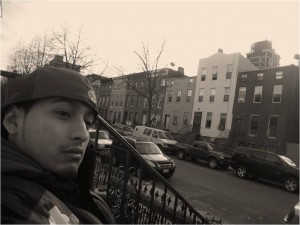
We took a Whitman tour, guided by a Whitman specialist; we walked from Fort Greene Park to 99 Ryerson Street. 99 Ryerson Street was one of many addresses in Brooklyn which Whitman called home; he lived at this location in 1855. We walked down Myrtle Ave which was the route Whitman would have taken on his way to work or on his way to the ferry. We walked by houses that stood there at Whitman’s time, houses he must have known. In the picture above I’m sitting on the same stoop Whitman had once sat on, probably after a long walk back home, or maybe on a sunny morning, watching people walk by on their way to work or kids running by playing. To the right (where I’m facing) is now an elevated highway which was definitely not there in 1855, and almost all the houses on the block were probably not there either. No cars would have been parked there, maybe a horse drawn carriage, and the streets we not paved. As I sat there on the stoop, I pictured Whitman at the age of 36 sitting on the steps with me, conversing with me about leaves of grass.
fabfab for dec 1

We took a Whitman tour, guided by a Whitman specialist; we walked from Fort Greene Park to 99 Ryerson Street. 99 Ryerson Street was one of many addresses in Brooklyn which Whitman called home; he lived at this location in 1855. We walked down Myrtle Ave which was the route Whitman would have taken on his way to work or on his way to the ferry. We walked by houses that stood there at Whitman’s time, houses he must have known. In the picture above I’m sitting on the same stoop Whitman had once sat on, probably after a long walk back home, or maybe on a sunny morning, watching people walk by on their way to work or kids running by playing. To the right (where I’m facing) is now an elevated highway which was definitely not there in 1855, and almost all the houses on the block were probably not there either. No cars would have been parked there, maybe a horse drawn carriage, and the streets we not paved. As I sat there on the stoop, I pictured Whitman at the age of 36 sitting on the steps with me, conversing with me about leaves of grass.
Fort Greene, for Dec 01, oatakan
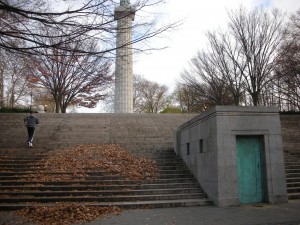
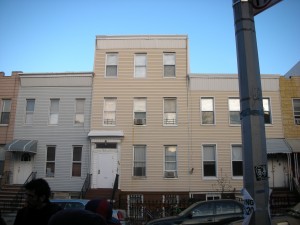 We had our second Whitman tour last week and I really enjoyed it. As a class we met at the Fort Greene Park which had monument dedicated for British Prison ship prisoners. A professional team greeted us. Leader of the team Greg Trupiano was passionate person about Whitman’s work. It was obvious he knew very well about Whitman and the history. After hearing about Whitman and Fort Greene park a wonderful voice Nicole sang us couple songs including The National Anthem, followed by a reader who read passages of Whitman. After all, it was interesting to know that some of the bones were collected from the shore and put into a room right on the stairs of the monument. Then we walked through the streets where Whitman lived through the myrtle avenue. We arrived at the address 99 Ryerson Street, where well known Whitman’s least changed place is is. The place looks very knew outside, however we were told just renovated outside, inside is still is the same as Whitman’s time. Over all, it was a great tour of Whitman in the neighborhood.
We had our second Whitman tour last week and I really enjoyed it. As a class we met at the Fort Greene Park which had monument dedicated for British Prison ship prisoners. A professional team greeted us. Leader of the team Greg Trupiano was passionate person about Whitman’s work. It was obvious he knew very well about Whitman and the history. After hearing about Whitman and Fort Greene park a wonderful voice Nicole sang us couple songs including The National Anthem, followed by a reader who read passages of Whitman. After all, it was interesting to know that some of the bones were collected from the shore and put into a room right on the stairs of the monument. Then we walked through the streets where Whitman lived through the myrtle avenue. We arrived at the address 99 Ryerson Street, where well known Whitman’s least changed place is is. The place looks very knew outside, however we were told just renovated outside, inside is still is the same as Whitman’s time. Over all, it was a great tour of Whitman in the neighborhood.
Fort Greene, for Dec 01, oatakan

 We had our second Whitman tour last week and I really enjoyed it. As a class we met at the Fort Greene Park which had monument dedicated for British Prison ship prisoners. A professional team greeted us. Leader of the team Greg Trupiano was passionate person about Whitman’s work. It was obvious he knew very well about Whitman and the history. After hearing about Whitman and Fort Greene park a wonderful voice Nicole sang us couple songs including The National Anthem, followed by a reader who read passages of Whitman. After all, it was interesting to know that some of the bones were collected from the shore and put into a room right on the stairs of the monument. Then we walked through the streets where Whitman lived through the myrtle avenue. We arrived at the address 99 Ryerson Street, where well known Whitman’s least changed place is is. The place looks very knew outside, however we were told just renovated outside, inside is still is the same as Whitman’s time. Over all, it was a great tour of Whitman in the neighborhood.
We had our second Whitman tour last week and I really enjoyed it. As a class we met at the Fort Greene Park which had monument dedicated for British Prison ship prisoners. A professional team greeted us. Leader of the team Greg Trupiano was passionate person about Whitman’s work. It was obvious he knew very well about Whitman and the history. After hearing about Whitman and Fort Greene park a wonderful voice Nicole sang us couple songs including The National Anthem, followed by a reader who read passages of Whitman. After all, it was interesting to know that some of the bones were collected from the shore and put into a room right on the stairs of the monument. Then we walked through the streets where Whitman lived through the myrtle avenue. We arrived at the address 99 Ryerson Street, where well known Whitman’s least changed place is is. The place looks very knew outside, however we were told just renovated outside, inside is still is the same as Whitman’s time. Over all, it was a great tour of Whitman in the neighborhood.
